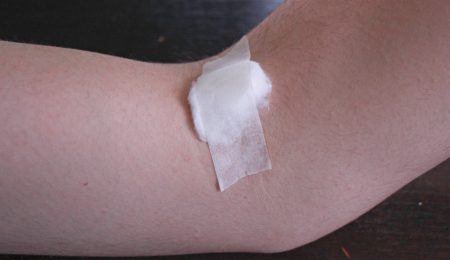GetaKit is a U of O research study bringing free HIV testing kits to Ontarians to the comfort of their homes
In the age of home delivery for almost anything, why not healthcare? We know clinicians increasingly rely on phone or video calls, but medical tests still require visiting a lab to draw blood or complete other procedures.
Screening tests, designed to identify people with a disease early to better help them, are increasingly becoming available for conditions such as colon cancer. However, many of these still require either an in-person or telephone consultation with a healthcare provider to confirm eligibility.
What if a well-calibrated algorithm could allow you to skip the visit or phone call, allowing you to order a free kit to test yourself, have it delivered to your home, and then let you complete some easy to follow directions to quickly obtain a lab result that you could then bring to a healthcare professional?
While not possible for all types of screening or diagnostic tests, GetaKit, a U of O research study, is bringing HIV testing to eligible Ontarians aged 16 years or older, not currently HIV positive, and who do not have a bleeding disorder. Free testing kits, which include easy-to-follow steps involving only a fingerstick to obtain a small blood sample to test, are designed to let the person test themselves when they are comfortable. Positive test results connect a person to HIV care and further testing, while people with negative results are also given information about reducing HIV risk through a PrEP [pre-exposure prophylaxis] clinic.
To tell us more, Dr. Patrick O’Byrne, a U of O school of nursing professor and nurse practitioner was kind enough to take some time to explain the significance of his project and how you too could test yourself for HIV in the comfort of your own home on your own time.
Answers have been edited for length and clarity.
The Fulcrum (TF): I was hoping you could tell me a little bit about what your project is and what you’re focusing on in your work.
Dr. Patrick O’Byrne (PO):
I guess there are a few different pieces. One is, despite years of excellent work and HIV testing and prevention, we have maintained the proportion of people who are unaware that they’re HIV positive. We’ve got it down to maybe 14 per cent, but that doesn’t achieve the UN AIDS 90/90/90 goals, let alone their new 95/95/95 [goals]. So we haven’t even achieved that.
The goal was to say, could we do self-testing and actually deliver it to people as a way to get more people access to testing? Then COVID-19 came around. [Self-testing] was actually an idea before COVID-19, but [the pandemic] came around and actually accelerated it because health services were effectively shuttered for in-person care. People who wanted to get access were wholly unable to, so we accelerated, saying, well, now we’ve actually reduced testing rates even further, so is this a new strategy we could implement for the study itself. These kits are licensed by Health Canada. You could go on to Biolytical and actually purchase one, to buy one online and have it shipped to Ottawa the cost is somewhere around $60, which is prohibitive to a lot of people, particularly to many people who are most affected by HIV. So the study’s purpose is to say, well, if we take these kits and we build an online system and the shipping is free and the test is free, what are the outcomes? Who uses them? At what rate? What proportion of people who use them are actually at risk for HIV acquisition? What are our diagnostic outcomes? Our linkages to care? And we use this language called “status neutral,” which means we have an intervention irrespective of test results, so if it’s invalid, retest, if it’s negative, know when to retest. Do you know about PEP (post-exposure prophylaxis)? Do you know about PrEP? Can we link you into the PrEP clinic that I run? If it’s positive counselling support, confirmatory testing, linkage to medical care for HIV treatment and so forth. So basically that’s what we’re looking at and what are the outcomes associated with it? In an effort, circling back to the beginning, to really address that proportion of people who are undiagnosed, and could contribute to lowering that number.
TF: How do you reach people who would obtain the most benefit from your tests? Have there been any challenges here?
PO: Absolutely. So we started with a targeted approach, postering and stickering information in downtown Ottawa around Centretown. This was based on a lot of what we do in public health work and research, which is better known due to COVID-19, people are now familiar with the hot spot idea. This is not new: geolocation and forward sorting, code mapping of infectious disease diagnosis, is a standard practice in public health, so it’s also to say OK, where are we getting the most diagnoses in the city and ensuring that we’re putting out paper-based material in those areas? We then worked with the AIDS service organizations like Max Ottawa, AIDS Community of Ottawa, and Planned Parenthood Ottawa, to get information out to target populations. Somerset West, which has the African Caribbean and Black community agencies and associations, as well through health promotion with the University of Ottawa, Carleton. We went after targeted associations trying to get information out. COVID-19 made it very difficult to reach people who weren’t technologically linked because we couldn’t see them in person. Since some of the restrictions have been lifted, and some outdoor events have been running, we have been attending those to promote information.
The Fulcrum: Did you have any issues with trying to sort out test results that were outside your population of interest, or are you throwing the net wide?
PO: We’re throwing the net wide, where we don’t restrict access to see the actual outcomes. We had, within the first year of data or similar, around 71 per cent [of study participants] belong to what the province calls priority groups, which would be gay, bisexual, men who have sex with men; people of African, Caribbean, Black ethnicities; persons who are trans, and people who use drugs from endemic regions; members of Indigenous communities. So we did just through the targeted advertising get between two-thirds to three-fourths in those groups. For test results, there is no obligation for people to report results back, but we do remind them a couple of times as part of the study protocol and ask them to do so. Reporting rates are, I think, around 60 per cent or so, which sort of matches what the literature has [found] in international settings.
In the first 800 tests, we had four positive results, which is the 1 in 200 positivity rate. That’s exceptionally high for Ottawa. It’s usually 1 in 1,000 to 1 in 1,250 tests we have to run to identify one new diagnosis, so it’s markedly higher. I can confirm that all four people were linked to care and seen by an HIV care provider within seven days of reporting the positive test result to us.
TF: What happens to someone who obtains a positive test result? How do you support someone when they do the kit at home and then get their results?
PO: This is super interesting because self-testing is, by definition, supposed to be done alone and by yourself. And from the beginning this is actually something that my team pushed back against saying self-testing is done by you, in that it literally puts testing in your own hands, you do it where you want, when you want, but it shouldn’t be alone, right? And so self and alone are not the same thing. This sort of approach we took was, you’re self-testing but you’re not testing alone.
So the system itself is dynamic. We give information in advance if somebody comes back to report a result to us, the system automatically will put information onto the user screen. Plus, it will send a text or email immediately. We are, on the study team side, immediately notified at the moment that a positive result is reported and we log into the system to find the person and reach out to them by phone immediately. Then we will set up whatever linkages are required. So we go through all of those items in whatever order the person has questions and wants to go through. We also have established linkage to care clinics, meaning that we have established warm handoffs at any site where we offer testing so somebody wouldn’t walk into a clinic and they would say “I have absolutely no idea what you’re doing here.” We have these linkages. The system also puts up a confirmatory testing sheet which says you’ve tested positive. The second page is a clinician info sheet so it says, “Take this to whoever you’re going to see”. It actually gives a very clinical sheet, which includes the sensitivity to specificity, this is the specific test recommended, next steps to follow.
TF: Can you speak a little bit more about the project’s expansion? How is it growing outside of its original home here in Ottawa?
PO: We ran in Ottawa from July 2020 through March of 2021. On April 1, we launched at the Black Coalition for AIDS Prevention (Black CAP) in Toronto. We had people asking since day one if they could join, and I said I didn’t have any funding or mandate to do that, and then expansion funds were provided to me by the Ministry of Health and they gave a little bit of direction on where they would like to see testing. They had designated certain sites that they wanted, such as Black CAP. We launched with them and now we’re up to 13 or 14 different sites. Those which are pending are the Francophone HIV Association for Ontario and Two Spirits, which is in Toronto.
TF: How do you think your project works with the change in the way that we view HIV with reducing the stigma and supporting people?
PO: That’s one of the things I like. HIV has such exceptionalism to it, which on the one side you aren’t going to be potentially prosecuted for chlamydia, but you will be for HIV, so there is exceptionalism that exists in the legal system. Absolutely, society views it differently. In healthcare, we have to respect that, and understand that informed consent is required in all information that is given to people.
So some of the legal part, the actual information that people receive before consenting to the test, I worked out with the HIV/AIDS Legal Clinic Ontario as well to make sure the language was what they as the community lawyers who work on the defense side agreed was appropriate. I think within clinical services it’s always important that we adopt new approaches, use new research, but the shift towards reducing HIV exceptionalism should never be so radical that it could potentially put patients in peril. So this is just a gentle sort of shift toward getting services like everything else.
TF: Could you speak a little bit more to that inversion of the system of letting people bring health care to them through their phones or almost like an Uber Eats of health care?
PO: So there are two parts to this. One is: am I advocating for you to walk in and you could basically say I want a full-body Magnetic Resonance Image (MRI)? Absolutely not. What we did was we took the risk assessment that’s established from the [United States] Center for Disease Control (CDC) and the Public Health Agency of Canada and figured out how to actually automate it, and we have run through close to probably 1,500 test cases, and it’s really not failing anymore. It was at the beginning, and we were refining and figuring out the exact math and calculations that needed to be done to not fail anymore. So I think it’s nice that we have the ability to do that, but it shouldn’t be unrestricted, so that’s the point there.
The second part is this democratization, where people are being given the ability to test how they want, where they want, when they want, with whom they want, how they find out the result, and to whom they disclose this information. There are harms and dangers to self-testing. There’s harms and dangers to every test, and we want to make sure that we target testing toward those who will have the highest positive predictive value. Where is the prevalence highest. So it’s kind of two parts to it. Do I think it’s nice that we’ve had the ability to do this? Yes, but it needs a lot of work to go into it before you let people have access.
TF: What do you see as the next steps for this kind of project?
PO: STIs. We will have full STI testing, hopefully within a year. It’s just moving toward how we implement that safely, and that’s a bit different from self-testing, because those are laboratory-based tests. They would be people who are mailed the actual requisitions and or swabs, which they would then need to take to a local laboratory for deposition and sent off to the lab. You need a local clinician because if labs come back positive you need to physically be able to treat people, so this is not a provincial-wide project: we would have designated sites in Ottawa and Hamilton.
Ontario readers who are interested in obtaining a free HIV or COVID-19 test kit can visit getakit.ca to determine if they are eligible to receive one.




